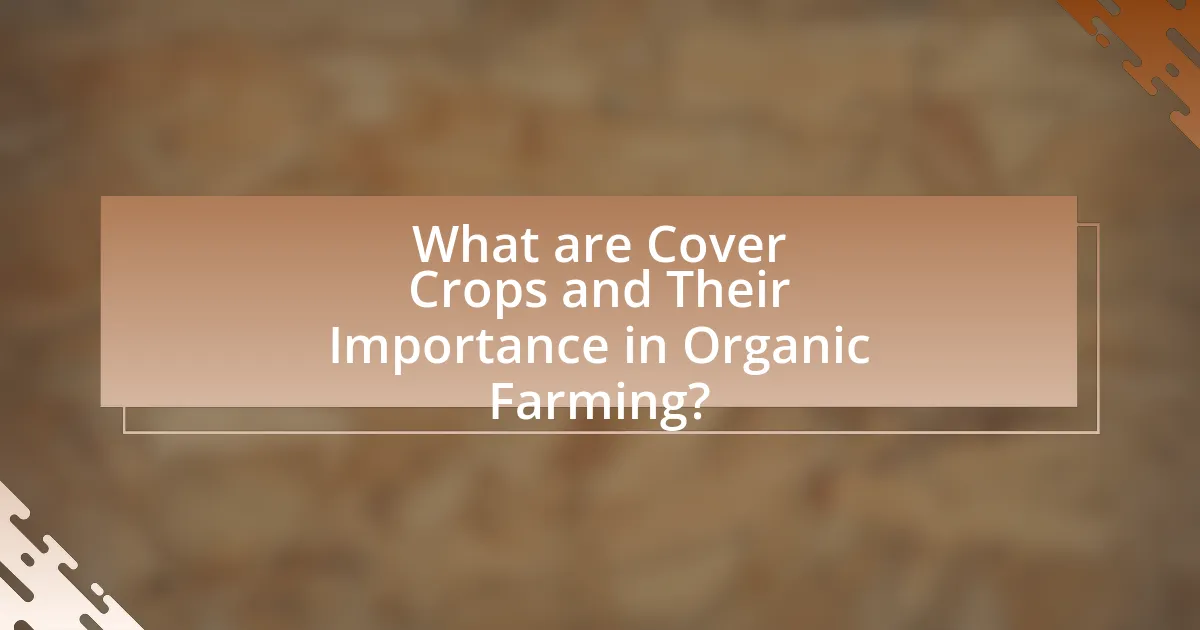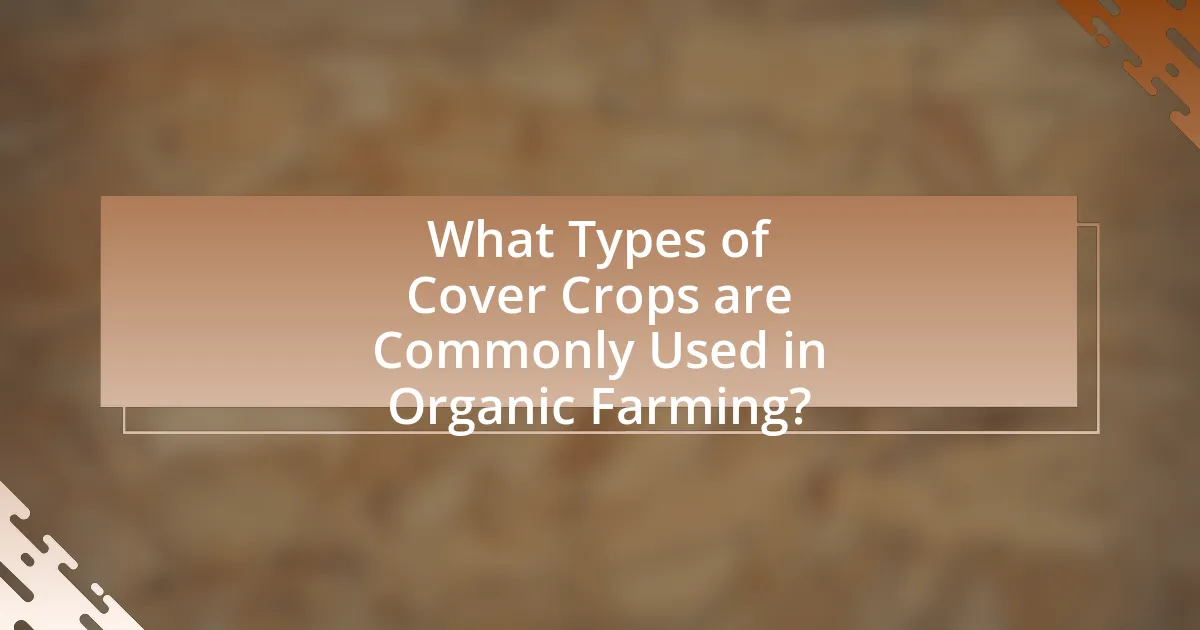Cover crops are essential plants used in organic farming to enhance soil health, prevent erosion, and improve nutrient cycling. They contribute to increased soil organic matter, suppress weeds, and reduce nutrient leaching, with legumes playing a significant role in nitrogen fixation. The article explores the various benefits of cover crops, including their impact on soil structure, nutrient availability, and biodiversity, while also discussing the types of cover crops commonly used and best practices for their implementation. Additionally, it addresses the challenges farmers face in adopting cover crops and the economic considerations associated with their use in sustainable agriculture.

What are Cover Crops and Their Importance in Organic Farming?
Cover crops are plants grown primarily to improve soil health, prevent erosion, and enhance nutrient cycling in organic farming. They play a crucial role in organic agriculture by increasing soil organic matter, suppressing weeds, and reducing nutrient leaching. Research indicates that cover crops can increase soil fertility by fixing nitrogen, as seen with legumes, and improving soil structure through root biomass, which enhances water infiltration and aeration. Studies have shown that farms utilizing cover crops can experience up to a 30% increase in soil organic carbon levels, contributing to overall soil health and sustainability in organic farming practices.
How do cover crops contribute to soil health?
Cover crops enhance soil health by improving soil structure, increasing organic matter, and promoting biodiversity. These crops, such as clover and rye, prevent soil erosion, enhance water retention, and contribute to nutrient cycling. Research indicates that cover crops can increase soil organic carbon levels by 0.1 to 0.3% per year, which significantly boosts soil fertility and microbial activity. Additionally, they suppress weeds and pests, reducing the need for chemical inputs, thereby fostering a healthier ecosystem.
What specific benefits do cover crops provide to soil structure?
Cover crops improve soil structure by enhancing soil aggregation, increasing porosity, and reducing compaction. These plants contribute organic matter through root biomass and decaying plant material, which fosters the formation of stable soil aggregates. Research indicates that cover crops can increase soil organic carbon levels, which is crucial for maintaining soil structure. For example, a study published in the journal “Agronomy” found that cover crops significantly improved soil aggregate stability, leading to better water infiltration and reduced erosion. This evidence supports the assertion that cover crops play a vital role in enhancing soil structure in organic farming systems.
How do cover crops enhance nutrient availability in the soil?
Cover crops enhance nutrient availability in the soil by improving soil structure and increasing organic matter content. These plants, such as legumes, fix atmospheric nitrogen, making it accessible to subsequent crops, while their root systems create channels that enhance water infiltration and aeration. Research indicates that cover crops can increase soil organic carbon levels by 0.1 to 0.3% annually, which contributes to nutrient retention and availability. Additionally, the decomposition of cover crop biomass releases nutrients slowly, providing a steady supply for growing plants.
Why are cover crops essential for sustainable agriculture?
Cover crops are essential for sustainable agriculture because they improve soil health, enhance biodiversity, and reduce erosion. By planting cover crops, farmers can increase organic matter in the soil, which leads to better nutrient retention and improved soil structure. Research indicates that cover crops can reduce soil erosion by up to 90% compared to bare soil, thereby protecting the land from degradation. Additionally, cover crops support beneficial organisms, such as earthworms and microbes, which contribute to a more resilient agricultural ecosystem.
What role do cover crops play in preventing soil erosion?
Cover crops play a crucial role in preventing soil erosion by stabilizing the soil with their root systems. These plants create a protective cover that reduces the impact of rainfall on the soil surface, thereby minimizing soil displacement. Research indicates that cover crops can reduce soil erosion rates by up to 90% compared to bare soil, as demonstrated in studies conducted by the USDA Natural Resources Conservation Service. Additionally, the organic matter from decomposed cover crops enhances soil structure, further contributing to erosion resistance.
How do cover crops support biodiversity in farming systems?
Cover crops support biodiversity in farming systems by providing habitat and food sources for various organisms, including beneficial insects, soil microbes, and wildlife. These crops enhance soil structure and fertility, which in turn promotes a diverse ecosystem. Research indicates that cover crops can increase the abundance and diversity of soil microbial communities, which are crucial for nutrient cycling and soil health. For instance, a study published in the journal “Agriculture, Ecosystems & Environment” found that fields with diverse cover crops had significantly higher levels of beneficial nematodes and earthworms compared to monoculture systems. This increase in biodiversity contributes to pest control, pollination, and overall ecosystem resilience, making farming systems more sustainable.

What Types of Cover Crops are Commonly Used in Organic Farming?
Commonly used cover crops in organic farming include legumes, grasses, and brassicas. Legumes such as clover and vetch are favored for their ability to fix nitrogen in the soil, enhancing fertility. Grasses like rye and oats are utilized for their deep root systems, which improve soil structure and prevent erosion. Brassicas, including radishes, are effective at breaking up compacted soil and suppressing weeds. Research indicates that these cover crops contribute to improved soil health by increasing organic matter and promoting beneficial microbial activity.
What are the most effective cover crop species for different climates?
The most effective cover crop species vary by climate, with specific species suited to different environmental conditions. In temperate climates, species such as rye, clover, and vetch are effective due to their ability to improve soil structure and nitrogen content. In arid regions, legumes like cowpeas and sunn hemp thrive, providing essential nutrients while conserving moisture. Tropical climates benefit from cover crops like millet and sorghum, which enhance soil fertility and prevent erosion. Research indicates that these species not only improve soil health but also support biodiversity and pest management, making them integral to organic farming practices.
How do legumes function as cover crops in enhancing soil nitrogen?
Legumes function as cover crops in enhancing soil nitrogen primarily through a process called nitrogen fixation. This process involves symbiotic bacteria, such as Rhizobium, that reside in the root nodules of legume plants, converting atmospheric nitrogen into a form that plants can utilize. Research indicates that legumes can increase soil nitrogen levels by 50 to 200 pounds per acre, depending on the species and growing conditions. This nitrogen enrichment not only improves soil fertility but also supports subsequent crops by providing essential nutrients, thereby enhancing overall soil health in organic farming systems.
What are the benefits of using grasses as cover crops?
Grasses as cover crops provide numerous benefits, including soil erosion control, improved soil structure, and enhanced nutrient cycling. These grasses establish a protective layer over the soil, reducing erosion by wind and water, which is crucial in maintaining soil integrity. Additionally, their root systems help to improve soil structure by increasing porosity and promoting water infiltration. Grasses also contribute to nutrient cycling by capturing nitrogen and other nutrients, which can be released back into the soil when the cover crop is terminated, thus enhancing soil fertility. Research indicates that using grasses as cover crops can lead to a 20-30% increase in soil organic matter over time, further supporting soil health in organic farming systems.
How can farmers select the right cover crops for their specific needs?
Farmers can select the right cover crops by assessing their specific soil health goals, climate conditions, and crop rotation plans. For instance, if a farmer aims to improve nitrogen levels in the soil, they might choose legumes such as clover or vetch, which are known for their nitrogen-fixing capabilities. Additionally, understanding the local climate is crucial; for example, farmers in cooler regions may prefer winter rye, which can survive frost and provide ground cover during the off-season. Research indicates that cover crops can reduce soil erosion by up to 90% and improve soil organic matter, thus enhancing overall soil health (USDA Natural Resources Conservation Service). By aligning cover crop selection with these factors, farmers can effectively meet their specific agricultural needs.
What factors should be considered when choosing cover crops?
When choosing cover crops, factors such as soil type, climate, crop rotation, and specific agricultural goals must be considered. Soil type influences the selection of cover crops that can thrive and improve soil structure; for instance, legumes enhance nitrogen levels in sandy soils. Climate affects the growth cycle and viability of cover crops, with cool-season crops suitable for temperate regions and warm-season crops for warmer areas. Crop rotation practices determine which cover crops can effectively suppress weeds and pests while enhancing soil health. Additionally, specific agricultural goals, such as erosion control, nutrient management, or weed suppression, guide the selection process. Research indicates that selecting appropriate cover crops can lead to improved soil organic matter and overall soil health, as evidenced by studies showing increased microbial activity and nutrient availability in fields with well-chosen cover crops.
How do cover crop mixtures compare to single species in effectiveness?
Cover crop mixtures generally outperform single species in effectiveness for enhancing soil health. Research indicates that mixtures can improve nutrient cycling, increase biomass production, and enhance soil structure compared to single-species cover crops. For instance, a study published in the journal “Agronomy” by Teasdale et al. (2019) found that cover crop mixtures led to higher soil organic matter and improved microbial diversity, which are critical for soil health. Additionally, mixtures can provide complementary benefits, such as pest suppression and weed control, which single species may not achieve as effectively.

What Practices Enhance the Effectiveness of Cover Crops in Organic Farming?
Practices that enhance the effectiveness of cover crops in organic farming include selecting appropriate species, optimizing planting timing, and employing proper management techniques. Selecting species that are well-suited to local soil and climate conditions can improve biomass production and nutrient cycling. For instance, legumes like clover and vetch can fix nitrogen, enriching the soil. Optimizing planting timing ensures that cover crops establish before winter, maximizing growth and soil coverage. Additionally, proper management techniques, such as terminating cover crops at the right growth stage, can enhance their benefits by preventing competition with cash crops and promoting soil health. Research indicates that these practices can lead to improved soil structure, increased organic matter, and enhanced microbial activity, all of which contribute to better crop yields in organic farming systems.
How should cover crops be managed for optimal soil health benefits?
Cover crops should be managed by selecting appropriate species, timing their planting and termination, and implementing proper nutrient management practices to maximize soil health benefits. Choosing diverse cover crop species, such as legumes and grasses, enhances soil structure, increases organic matter, and promotes beneficial microbial activity. Timing is crucial; cover crops should be planted early enough to establish before winter and terminated at the right growth stage to optimize biomass and nutrient release. Additionally, integrating cover crops into a nutrient management plan ensures that they contribute to soil fertility without depleting existing soil nutrients. Research indicates that cover crops can improve soil organic carbon levels by 0.1 to 0.3% annually, significantly enhancing soil health over time.
What are the best practices for planting and terminating cover crops?
The best practices for planting cover crops include selecting appropriate species based on climate, soil type, and desired benefits, such as nitrogen fixation or erosion control. Additionally, planting cover crops at the right time, typically in late summer or early fall, ensures optimal growth before winter. For terminating cover crops, methods such as mowing, rolling, or using herbicides should be employed at the appropriate growth stage, usually just before flowering, to maximize biomass and nutrient release while minimizing competition with cash crops. Research indicates that proper management of cover crops can enhance soil structure, increase organic matter, and improve nutrient cycling, contributing to overall soil health in organic farming systems.
How can cover crops be integrated into crop rotation plans?
Cover crops can be integrated into crop rotation plans by strategically planting them during fallow periods or between cash crops to improve soil health and fertility. This practice enhances soil structure, reduces erosion, and increases organic matter, which is crucial for sustainable organic farming. Research indicates that cover crops like clover and rye can fix nitrogen and suppress weeds, leading to improved yields in subsequent cash crops. For instance, a study published in the Journal of Soil and Water Conservation found that integrating cover crops in rotation increased soil organic carbon levels by 0.5 to 1.0 tons per hectare annually, demonstrating their effectiveness in enhancing soil health.
What challenges do farmers face when implementing cover crops?
Farmers face several challenges when implementing cover crops, including increased costs, management complexity, and potential competition with cash crops. The initial investment for seeds and planting can be significant, which may deter farmers, especially those with tight budgets. Additionally, managing cover crops requires knowledge and skills that some farmers may lack, leading to difficulties in integrating them into existing farming practices. Furthermore, cover crops can compete for nutrients and water with cash crops, potentially impacting yields if not managed properly. Research indicates that these challenges can hinder the widespread adoption of cover crops, despite their benefits for soil health and sustainability in organic farming.
How can farmers overcome common obstacles in cover crop management?
Farmers can overcome common obstacles in cover crop management by implementing strategic planning and utilizing appropriate species selection. Effective planning involves assessing soil health, climate conditions, and crop rotation schedules to choose cover crops that will thrive in specific environments. For instance, legumes can fix nitrogen, improving soil fertility, while deep-rooted species can enhance soil structure and moisture retention. Research indicates that integrating cover crops can lead to a 10-20% increase in soil organic matter over time, which is crucial for enhancing soil health. Additionally, farmers can adopt practices such as intercropping and using cover crops as green manure to maximize benefits while minimizing competition with cash crops.
What are the economic considerations of using cover crops in organic farming?
The economic considerations of using cover crops in organic farming include initial costs, potential savings on inputs, and long-term benefits to soil health and crop yields. Cover crops require upfront investment for seeds and planting, which can range from $20 to $100 per acre depending on the species and management practices. However, they can reduce the need for synthetic fertilizers and pesticides, leading to savings that can offset these initial costs. Research indicates that cover crops can improve soil structure and fertility, resulting in increased crop yields; for instance, a study published in the Journal of Soil and Water Conservation found that cover crops can enhance corn yields by 5-15% in subsequent seasons. Additionally, the use of cover crops can lead to reduced erosion and improved water retention, which further contributes to economic sustainability in organic farming.
What are the best practices for implementing cover crops effectively?
The best practices for implementing cover crops effectively include selecting appropriate species, timing the planting and termination, and ensuring proper management techniques. Selecting species that are well-suited to the local climate and soil conditions enhances growth and benefits, such as nitrogen fixation or weed suppression. Timing is crucial; planting cover crops during fallow periods maximizes their growth and benefits before the main crop cycle. Proper management techniques, including adequate soil preparation and monitoring for pests and diseases, ensure that cover crops thrive and contribute positively to soil health. Research indicates that cover crops can improve soil structure, increase organic matter, and enhance nutrient cycling, which are essential for sustainable organic farming practices.










